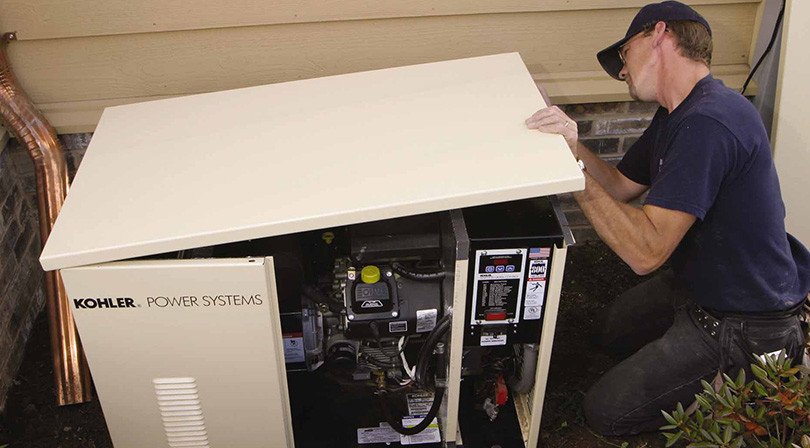By James Dulley –

An ATS (automatic transfer switch) is mounted on the wall near the breaker panel. It switches from the utility power to generator power automatically. Photo credit – Kohler
This is a whole-house sized standby generator being installed at a home. Notice the small gas engine inside the housing. Photo credit – KohlerThese days, most families depend on electricity for nearly every activity, so purchasing a backup generator is becoming more common.
Residential backup generators are called standby models because they are only used when electricity from the utility grid fails. They are designed to run for a relatively short period of time until power is restored. Outages like this usually last between a few hours and a couple of days.
First, you must decide how much of your home you want to power in order to determine the size of backup generator you need. There are common necessities, such as refrigeration and lighting, which you will definitely need. Others, such as air-conditioning, washing and drying clothes, and vacuuming may not be top priority during a power outage. This is a whole-house sized standby generator installed on a concrete pad in the backyard of a house.
Backup generators are sized by their kilowatt electricity output. A 12-KW generator can power most electrical needs of a typical family of four. If you can eliminate nonessentials, a smaller, less expensive unit will be adequate and the fuel costs to operate it will be less.

This is a whole-house sized standby generator being installed at a home. Notice the small gas engine inside the housing. Photo credit – Kohler
To get a rough idea of the size of generator you need, list all electric items you want to power and total their wattages. Items and appliances with motors often require more electric current at start-up time, so round up when determining the total wattage. A contractor or installation expert can also advise you on the proper size. It should be noted that installing a whole-house backup generator is not a do-it-yourself project.
An ATS (automatic transfer switch) is mounted on the wall near the breaker panel. It switches from the utility power to generator power automatically. Photo credit – KohlerFor convenience and safety (for both your family and your electric co-op’s emergency lineworkers), install an automatic transfer switch. This switch senses when the grid electricity goes off or the voltage drops below a critical point, also known as a brownout. It automatically disconnects your home’s wiring from the utility grid and starts the generator. This occurs quickly, so there is very little down time.
The ATS also runs the generator periodically (called exercising) to ensure everything is working properly. You may hear the generator start the exercise cycle, so don’t be alarmed – the power may not be off.If you have natural gas available at your house, this is the best fuel to power the backup generator. Natural gas engines run cleanly, require little maintenance and are relatively inexpensive to run. Also, if you have natural gas, you probably have a gas furnace for heat, so the size of the generator required is smaller.

This is a whole-house sized standby generator installed on a concrete pad in the backyard of a house. Photo credit – Kohler
Another clean-running fuel for a backup generator is propane. Many homes with electric heat still have propane available for cooking. In order to power a whole-house generator, a larger propane tank would be required. Even though propane is considered a clean running fuel, it is more expensive to use than natural gas.
This shows the typical electrical connection from a standby generator to the house wiring. Photo credit – KohlerA diesel engine-powered generator also requires a fuel tank. Even with a stabilizer, the shelf life of the diesel fuel is only a couple of years and the overall cost of installing a diesel generator will be higher. However, one advantage of using diesel is that you can always pour more fuel into the tank if you need to run the generator longer than originally expected.

This shows the typical electrical connection from a standby generator to the house wiring. Photo credit – Kohler
Another option is a smaller, less-expensive portable gasoline-powered generator with several electrical outlets. This will provide enough electricity for the refrigerator and several lamps. These models also provide enough power to operate the blower in a gas, propane or oil furnace for heat.
Never attempt to plug this type of generator into an electrical output with a homemade double-male cord. This can backfeed 120-volt current into the grid, which is dangerous for utility line crews. For more information on backup generators, contact your local electric co-op or speak with a qualified contractor.

